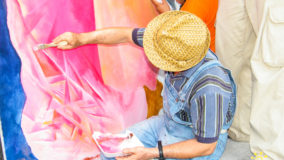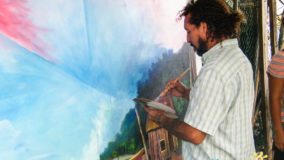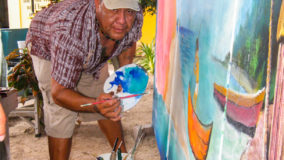San Pedro Town, located on the tourism island of Ambergris Caye is rich in history and culture. The origin of the people, the change in demographic of the island, the industries and activities practiced on the island, the festivities; they all contribute to the richness of the island’s town. But to understand and appreciate a place it’s often good to know a bit of the history. A group of over 20 local and regional artists decided to capture the essence of the history that links the island of Ambergris Caye to the southern part of Mexico and includes the original settlers and then the re-occupation of the area in the early 1800’s through a colorful mural.
A huge mural measuring eight feet high by fifteen feet wide took three days to complete. The painting is a first of its kind in Belize between artists from the region. They brainstormed how best history could be portrayed with the use of brushes and colorful paints on canvas. They decided to incorporate the Maya civilization and their continuous occupation of the region until the arrival of the Spaniards. Artists also included trade activities that formed a part of the regional trade, the importance of the environment and it linkages to the region and the people who once influenced the area.
The history unravels from a queen conch shell which forms a part of Mexican southern territory. The artists felt that painting the history from out of a shell was significant since conch was used in many ways by the Maya ancestors of the island. Be it for the purpose of music, jewelry or for its flesh, the conch is still used in modern day San Pedro. On the shell itself, the faces of both a Maya woman and man graces the painting showing their historical contribution to the region. This is cemented by the presence of the ruins of Tulum and Fort of Bacalar, Mexico. The two historical buildings is symbolic to the island. They figuratively express where the second set of settlers to the island came from before and during the 1840’s Caste War. The two parcels of land are separated by sea, symbolically representative of two countries in region; one side is the Mexican southern territory and the other is Belize’s Ambergris Caye.
The mural also shows three males. One is a dark skinned male casting his fishing net into shallow waters of the shores – an activity still practiced today by some traditional fishermen. The second is a Maya male, he is mounted on a canoe and is clearly seen harpooning for fish. The third is believed to be a Mestizo on the beach – peeling coconut. Coconut, for a very long period, was exported from off the island to make cooking oil and other products. This industry was eventually overtaken by fisheries.
The small island, representative of Ambergris Caye, has a rustic village setting and includes a small thatch house and a sail boat in the background. It brings forth memories a quaint fishing island. The canvas also depicts the lush green forest of Belize – highlighted by a tall Mahogany Tree and a Chicle Tree – very symbolic of the Belize’s rich history as it relates to past trades that dominated the region.
The base of the mural is decorated with a colorful reef. It shows that despite the territorial division, the two countries are joined not only by the families’ ties, but also by nature – one Mesoamerican Barrier Reef. Prominently displayed is the Caribbean Spiny Lobster, an eagle ray, a Blue Tang fish and a beautiful and rich coral formation.
The rich, colorful painting is a gorgeous piece that not only depicts the island’s history but also leaves much to the imagination. What makes it even more amazing is that the painting brings some of the most respected artists from Southern Mexico together. The Mexican artists exchanged ideas with local Belizean artists who all got together and interpreted the history of a community through one artistic piece.
The mural, while it is a gift to the island of Ambergris Caye, will be traveling all over the region and perhaps the world. It will serve as both a marketing tool for the island and a memorable art piece for generations to come. It is the hope of the San Pedro Town Council to have the mural displayed for six months of the year in a centralized location so that visitors and locals can appreciate the history of the island through art.

















